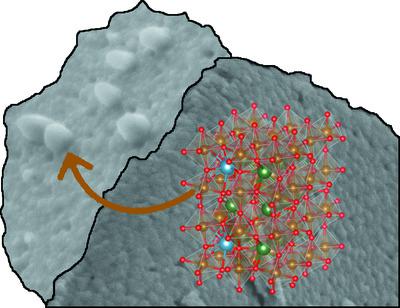当前位置:
X-MOL 学术
›
Acta Cryst. B
›
论文详情
Our official English website, www.x-mol.net, welcomes your
feedback! (Note: you will need to create a separate account there.)
Ca‐doped rare earth perovskite materials for tailored exsolution of metal nanoparticles
Acta Crystallographica Section B ( IF 1.3 ) Pub Date : 2020-12-07 , DOI: 10.1107/s2052520620013475 Lorenz Lindenthal , Thomas Ruh , Raffael Rameshan , Harald Summerer , Andreas Nenning , Christopher Herzig , Stefan Löffler , Andreas Limbeck , Alexander Karl Opitz , Peter Blaha , Christoph Rameshan
Acta Crystallographica Section B ( IF 1.3 ) Pub Date : 2020-12-07 , DOI: 10.1107/s2052520620013475 Lorenz Lindenthal , Thomas Ruh , Raffael Rameshan , Harald Summerer , Andreas Nenning , Christopher Herzig , Stefan Löffler , Andreas Limbeck , Alexander Karl Opitz , Peter Blaha , Christoph Rameshan

|
Perovskite‐type oxide materials (nominal composition ABO3) are a very versatile class of materials, and their properties are tuneable by varying and doping A‐ and B‐site cations. When the B‐site contains easily reducible cations (e.g. Fe, Co or Ni), these can exsolve under reducing conditions and form metallic nanoparticles on the surface. This process is very interesting as a novel route for the preparation of catalysts, since oxide surfaces decorated with finely dispersed catalytically active (often metallic) nanoparticles are a key requirement for excellent catalyst performance. Five doped perovskites, namely, La0.9Ca0.1FeO3–δ, La0.6Ca0.4FeO3–δ, Nd0.9Ca0.1FeO3–δ, Nd0.6Ca0.4FeO3–δ and Nd0.6Ca0.4Fe0.9Co0.1O3–δ, have been synthesized and characterized by experimental and theoretical methods with respect to their crystal structures, electronic properties, morphology and exsolution behaviour. All are capable of exsolving Fe and/or Co. Special emphasis has been placed on the influence of the A‐site elemental composition on structure and exsolution capability. Using Nd instead of La increased structural distortions and, at the same time, hindered exsolution. Increasing the amount of Ca doping also increased distortions and additionally changed the Fe oxidation states, resulting in exsolution being shifted to higher temperatures as well. Using the easily reducible element Co as the B‐site dopant significantly facilitated the exsolution process and led to much smaller and homogeneously distributed exsolved particles. Therefore, the Co‐doped perovskite is a promising material for applications in catalysis, even more so as Co is catalytically a highly active element. The results show that fine‐tuning of the perovskite composition will allow tailored exsolution of nanoparticles, which can be used for highly sophisticated catalyst design.
中文翻译:

钙掺杂的稀土钙钛矿材料,用于金属纳米颗粒的定制洗脱
钙钛矿型氧化物材料(标称成分AB O 3)是一类用途非常广泛的材料,其性质可通过改变和掺杂A和B位阳离子来调节。当B位含有易还原的阳离子(例如铁,钴或镍)时,它们可以在还原条件下溶解并在表面形成金属纳米颗粒。该方法作为制备催化剂的新途径非常有趣,因为用精细分散的催化活性(通常为金属)纳米颗粒装饰的氧化物表面是出色催化剂性能的关键要求。五种掺杂钙钛矿,即La 0.9 Ca 0.1 FeO合成了3-δ,La 0.6 Ca 0.4 FeO3 -δ,Nd 0.9 Ca 0.1 FeO3 -δ,Nd 0.6 Ca 0.4 FeO3 -δ和Nd 0.6 Ca 0.4 Fe 0.9 Co 0.1 O3 -δ并进行了表征关于晶体结构,电子性能,形态和析出行为的实验和理论方法。所有人都有能力溶解铁和/或钴。特别强调了A的影响现场关于结构和解脱能力的元素组成。使用Nd代替La会增加结构变形,同时也阻碍了脱模。Ca掺杂量的增加也增加了畸变,并另外改变了Fe的氧化态,导致析出物也转移到更高的温度。使用易还原元素Co作为B现场掺杂剂极大地促进了溶解过程,并导致溶解颗粒更小,分布更均匀。因此,Co掺杂的钙钛矿是一种有前途的材料,可用于催化,甚至在Co催化成为高活性元素时也是如此。结果表明,钙钛矿组成的微调将允许定制的纳米颗粒析出,可用于高度复杂的催化剂设计。
更新日期:2020-12-07
中文翻译:

钙掺杂的稀土钙钛矿材料,用于金属纳米颗粒的定制洗脱
钙钛矿型氧化物材料(标称成分AB O 3)是一类用途非常广泛的材料,其性质可通过改变和掺杂A和B位阳离子来调节。当B位含有易还原的阳离子(例如铁,钴或镍)时,它们可以在还原条件下溶解并在表面形成金属纳米颗粒。该方法作为制备催化剂的新途径非常有趣,因为用精细分散的催化活性(通常为金属)纳米颗粒装饰的氧化物表面是出色催化剂性能的关键要求。五种掺杂钙钛矿,即La 0.9 Ca 0.1 FeO合成了3-δ,La 0.6 Ca 0.4 FeO3 -δ,Nd 0.9 Ca 0.1 FeO3 -δ,Nd 0.6 Ca 0.4 FeO3 -δ和Nd 0.6 Ca 0.4 Fe 0.9 Co 0.1 O3 -δ并进行了表征关于晶体结构,电子性能,形态和析出行为的实验和理论方法。所有人都有能力溶解铁和/或钴。特别强调了A的影响现场关于结构和解脱能力的元素组成。使用Nd代替La会增加结构变形,同时也阻碍了脱模。Ca掺杂量的增加也增加了畸变,并另外改变了Fe的氧化态,导致析出物也转移到更高的温度。使用易还原元素Co作为B现场掺杂剂极大地促进了溶解过程,并导致溶解颗粒更小,分布更均匀。因此,Co掺杂的钙钛矿是一种有前途的材料,可用于催化,甚至在Co催化成为高活性元素时也是如此。结果表明,钙钛矿组成的微调将允许定制的纳米颗粒析出,可用于高度复杂的催化剂设计。











































 京公网安备 11010802027423号
京公网安备 11010802027423号